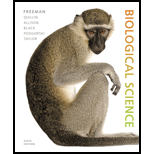
Concept explainers
What are the four nitrogenous bases found in RNA?
a. cytosine, guanine, thymine, uracil (C, G, T, U)
b. adenine, cytosine, guanine, thymine (A, C, G, T)
c. adenine, cytosine, guanine, uracil (A, C, G, U)
d. alanine, cysteine, glycine, threonine (A, C, G, T)
Introduction:
The five nitrogenous bases consist of nitrogen-containing molecule used in the construction of nucleotide, a polymer that is the building block of the nucleic acids like DNA (deoxyribonucleic acid) and RNA (ribonucleic acid).
Answer to Problem 1TYK
Correct answer:
Adenine, cytosine, guanine, and uracil (A, C, G, U)
Explanation of Solution
Explanation/Justification for the correct answer:
Option (c) is given that A, C, G, and U are the nitrogenous bases found in the RNA. A group of five nitrogenous bases is utilized in building the nucleotides. The nitrogenous bases include adenine, guanine, cytosine, thymine, and uracil. The nitrogenous bases can be purines or pyrimidines. The adenine and guanine are six-membered nitrogen-containing rings; and they fall under the purines. While, thymine, uracil, and cytosine are six-membered nitrogen-containing rings; and they fall under pyrimidines. Uracil is found in the RNA and complements adenine instead of thymine. Hence, option (c) is correct.
Explanation for incorrect answers:
Option (a) is given that C, G, T, and U are the nitrogenous bases found in the RNA. In case of DNA, adenine forms double bonds with thymine. Adenine complements either thymine or uracil. There is no strand that consists of both thymine and uracil. So, it is a wrong answer.
Option (b) is given that A, C, G, and T are the nitrogenous bases found in the RNA. A, C, G, and T nitrogenous bases are found in the DNA. In RNA, uracil is present in place of thymine. So, it is a wrong answer.
Option (d) is given that A, C, G, and T are the nitrogenous bases found in the RNA. Alanine, cysteine, glycine, and threonine are not found as nitrogenous bases in DNA or RNA. These are amino acids that form codons and each amino acid has multiple codons. So, it is a wrong answer.
The four nitrogenous bases found in RNA are adenine, cytosine, guanine, and uracil (A, C, G, U).
Want to see more full solutions like this?
Chapter 4 Solutions
Biological Science (6th Edition)
- Molecular Biology Question A gene that codes for a protein was removed from a eukaryotic cell and inserted into a prokaryotic cell. Although the gene was successfully transcribed and translated, it produced a different protein than it produced in the eukaryotic cell. What is the most likely explanation?arrow_forwardMolecular Biology LIST three characteristics of origins of replicationarrow_forwardMolecular Biology Question Please help. Thank you For E coli DNA polymerase III, give the structure and function of the b-clamp sub-complex. Describe how the structure of this sub-complex is important for it’s function.arrow_forward
- Molecular Biology LIST three characteristics of DNA Polymerasesarrow_forwardMolecular Biology RNA polymerase core enzyme structure contains what subunits? To form holo enzyme, sigma factor is added to core. What is the name of the structure formed? Give the detailed structure of sigma factor and the function of eachdomain. Please help. Thank youarrow_forwardMolecular Biology You have a single bacterial cell whose DNA is labelled with radioactiveC14. After 5 rounds of cell division, how may cells will contain radioactive DNA? Please help. Thank youarrow_forward
- 1. Explain the structure and properties of atoms and chemical bonds (especially how they relate to DNA and proteins). Also add some pictures.arrow_forward1. In the Sentinel Cell DNA integrity is preserved through nanoscopic helicase-coordinated repair, while lipids in the membrane are fortified to resist environmental mutagens. also provide pictures for this question.arrow_forwardExplain the structure and properties of atoms and chemical bonds (especially how they relate to DNA and proteins). Also add some pictures.arrow_forward
- In the Sentinel Cell DNA integrity is preserved through nanoscopic helicase-coordinated repair, while lipids in the membrane are fortified to resist environmental mutagens. also provide pictures for this question.arrow_forward1. Explain how genetic information is stored, copied, transferred, and expressed. Also add some pictures for this question.arrow_forward!. Describe biological macromolecules (DNA, RNA, proteins, lipids, etc.) and how they function in the cell. also provide some images for this question.arrow_forward
 Concepts of BiologyBiologyISBN:9781938168116Author:Samantha Fowler, Rebecca Roush, James WisePublisher:OpenStax College
Concepts of BiologyBiologyISBN:9781938168116Author:Samantha Fowler, Rebecca Roush, James WisePublisher:OpenStax College Human Heredity: Principles and Issues (MindTap Co...BiologyISBN:9781305251052Author:Michael CummingsPublisher:Cengage Learning
Human Heredity: Principles and Issues (MindTap Co...BiologyISBN:9781305251052Author:Michael CummingsPublisher:Cengage Learning
 Biology Today and Tomorrow without Physiology (Mi...BiologyISBN:9781305117396Author:Cecie Starr, Christine Evers, Lisa StarrPublisher:Cengage Learning
Biology Today and Tomorrow without Physiology (Mi...BiologyISBN:9781305117396Author:Cecie Starr, Christine Evers, Lisa StarrPublisher:Cengage Learning Human Biology (MindTap Course List)BiologyISBN:9781305112100Author:Cecie Starr, Beverly McMillanPublisher:Cengage Learning
Human Biology (MindTap Course List)BiologyISBN:9781305112100Author:Cecie Starr, Beverly McMillanPublisher:Cengage Learning Biology: The Dynamic Science (MindTap Course List)BiologyISBN:9781305389892Author:Peter J. Russell, Paul E. Hertz, Beverly McMillanPublisher:Cengage Learning
Biology: The Dynamic Science (MindTap Course List)BiologyISBN:9781305389892Author:Peter J. Russell, Paul E. Hertz, Beverly McMillanPublisher:Cengage Learning





